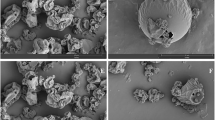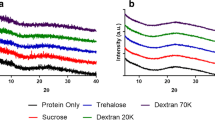Abstract
Purpose. To investigate the effect of atomization conditions on particle size and stability of spray-freeze dried protein.
Methods. Atomization variables were explored for excipient-free (no zinc added) and zinc-complexed bovine serum albumin (BSA). Particle size was measured by laser diffraction light scattering following sonication in organic solvent containing poly(lactide-co-glycolide) (PLG). Powder surface area was determined from the N2 vapor sorption isotherm. Size-exclusion chromatography (SEC) was used to assess decrease in percent protein monomer. Fourier-transform infrared (FTIR) spectroscopy was employed to estimate protein secondary structure. PLG microspheres were made using a non-aqueous, cryogenic process and release of spray-freeze dried BSA was assessed in vitro.
Results. The most significant atomization parameter affecting particle size was the mass flow ratio (mass of atomization N2 relative to that for liquid feed). Particle size was inversely related to specific surface area and the amount of protein aggregates formed. Zinc-complexation reduced the specific surface area and stabilized the protein against aggregation. FTIR data indicated perturbations in secondary structure upon spray-freeze drying for both excipient-free and zinc-complexed protein.
Conclusions. Upon sonication, spray-freeze dried protein powders exhibited friability, or susceptibility towards disintegration. For excipient-free protein, conditions where the mass flow ratio was > ∼0.3 yielded sub-micron powders with relatively large specific surface areas. Reduced particle size was also linked to a decrease in the percentage of protein monomer upon drying. This effect was ameliorated by zinc-complexation, via a mechanism involving reduction in specific surface area of the powder rather than stabilization of secondary structure. Reduction of protein particle size was beneficial in reducing the initial release (burst) of the protein encapsulated in PLG microspheres.
Similar content being viewed by others
REFERENCES
S. P. Schwendeman, M. Cardamone, M. R. Brandon, A. M. Klibanov, and R. Langer. Stability of proteins and their delivery from biodegradable polymer microspheres. In S. Cohen and H. Bernstein (eds.), Microparticulate systems for the delivery of proteins and vaccines, Marcel Dekker, New York, 1996 pp. 1-49.
O. L. Johnson, W. Jaworowicz, J. L. Cleland, L. Bailey, M. Charnis, E. Duenas, C. Wu, D. Shepard, S. Magil, T. Last, A. J. S. Jones, and S. D. Putney. The stabilization of human growth hormone into biodegradable microspheres. Pharm. Res. 14:730-735 (1997).
J. H. Crowe, J. F. Carpenter, L. M. Crowe, and T. J. Anchordoquy. Are freezing and dehydration similar stress vectors? A comparison of modes of interaction of stabilizing solutes with biomolecules. Cryobiology 27:219-231 (1990).
J. F. Carpenter, S. J. Prestrelski, and T. Arakawa. Separation of freezing and drying-induced denaturation of lyophilized proteins using stress-specific stabilization. I. Enzyme activity and calorimetric studies. Arch. Biochem. Biophys. 303:456-464 (1993).
S. J. Prestrelski, T. Arakawa, and J. F. Carpenter. Separation of freezing and drying-induced denaturation of lyophilized proteins using stress-specific stabilization. II. Structural studies using infrared spectroscopy. Arch. Biochem. Biophys. 303:465-473 (1993).
Y.-F. Maa, P.-A. Nguyen, T. Sweeney, S. J. Shire, and C. C. Hsu. Protein inhalation powders. Spray drying vs. spray freeze drying. Pharm. Res. 16:249-254 (1999).
S. Brunauer, P. H. Emmett, and E. Teller. Adsorption of gases in multimolecular layers. J. Am. Chem. Soc. 60:309-319 (1938).
K. Griebenow and A. M. Klibanov. On protein denaturation in aqueous-organic mixtures but not in pure organic solvents. J. Am. Chem. Soc. 118:11695-11700 (1996).
H. R. Costantino, K. G. Carrasquillo, R. A. Cordero, M. Mumenthaler, C. C. Hsu, and K. Griebenow. The effect of excipients on the structure and stability of lyophilized recombinant human growth hormone (rhGH). J. Pharm. Sci. 87:1412-1420 (1998).
K. G. Carrasquillo, R. A. Cordero, S. Ho, J. Franquiz, and K. Griebenow. Structure-guided encapsulation of bovine serum albumin in poly(DL-lactic-co-glycolic) acid. Pharm. Pharmacol. Commun. 4:563-571 (1998).
K. G. Carrasquillo, H. R. Costantino, R. A. Cordero, C. C. Hsu, and K. Griebenow. On the structural preservation of recombinant human growth hormone in a dried film of a synthetic biodegradable polymer. J. Pharm. Sci. 2:166-173 (1999).
H. R. Costantino, T. H. Nguyen, and C. C. Hsu. Fourier transform infrared spectroscopy demonstrates that lyophilization alters the secondary structure of recombinant human growth hormone. Pharm. Sci. 2:229-232 (1996).
P. Herbert, K. Murphy, O. Johnson, N. Dong, W. Jaworowicz, M. A. Tracy, J. L. Cleland, and S. D. Putney. A large-scale process to produce microencapsulated proteins. Pharm. Res. 15:357-361 (1998).
W. D. Rhine, D. S. T. Hsieh, and R. Langer. Polymers for sustained macromolecule release: procedures to fabricate reproducible delivery systems and control release kinetics. J. Pharm. Sci. 69:265-270 (1980).
R. A. Siegel and R. Langer. A new monte-carlo approach to diffusion in constricted porous geometries. J. Coll. I. Sc. 109:426-440 (1986).
J. A. Dean, Ed., Lange's Handbook of Chemistry, McGraw-Hill Book Company, New York, 1985.
Y.-F. Maa, P.-A. Nguyen, and S. W. Hsu. Spray-drying of air-liquid interface sensitive recombinant human growth hormone. J. Pharm. Sci. 87:152-159 (1998).
M. J. Pikal, S. Shah, D. Senior, and J. E. Lang. Physical chemistry of freeze-drying: measurement of sublimation rates for frozen aqueous solutions by a microbalance technique. J. Pharm. Sci. 72: 635-650 (1983).
B. M. Eckhart, J. Q. Oeswein, and T. A. Bewley. Effect of freezing on aggregation of human growth hormone. Pharm. Res. 11: 1360-1364 (1991).
H. Willemer. Measurements of temperature, ice evaporation rates and residual moisture contents in freeze-drying. Dev. Biol. Stand. 74:123-134 (1992).
J. A. House and J. C. Mariner. Stabilization of rinderpest vaccine by modification of the lyophilization process. Dev. Biol. Standard 87:235-244 (1996).
K. Masters. Spray Drying Handbook, John Wiley and Sons, New York, 1991.
C. C. Hsu, H. M. Nguyen, D. A. Yeung, D. A. Brooks, G. S. Koe, T. A. Bewley, and R. Pearlman. Surface denaturation at solid-void interface. A possible pathway by which opalescent particle form during the storage of lyophilized tissue-type plasminogen activator at high temperatures. Pharm. Res. 12:69-77 (1995).
B. Y. Chang, B. S. Kendrick, and J. F. Carpenter. Surface-induced denaturation of proteins during freezing and its inhibition by surfactants. J. Pharm. Sci. 85:1325-1330 (1996).
G. B. Strambini and E. Gabellieri. Proteins in frozen solutions. Evidence of ice-induced partial folding. Biophys. J. 70:971-976 (1996).
K. Fu, K. Griebenow, L. Hsieh, A. M. Klibanov, and R. Langer. FTIR characterization of proteins encapsulated within PLGA microspheres. J. Control. Release 58:357-366 (1999).
H. R. Costantino, L. Shieh, A. M. Klibanov, and R. Langer. Heterogeneity of serum albumin with respect to solid-state aggregation via thiol-disulfide interchange-Implications for sustained release from polymers. J. Control. Release 44:255-261 (1997).
R. M. C. Dawson, D. C. Elliot, W. H. Elliot, and K. M. Jones, Eds. Data for Biochemical Research, Oxford University Press, New York, 1994.
H. R. Costantino, K. Griebenow, P. Mishra, R. Langer, and A. M. Klibanov. Fourier-transform infrared (FTIR) spectroscopic investigation of protein stability in the lyophilized form. Biochim. Biophys. Acta 1253:69-74 (1995).
V. E. Bychkova, O. B. Ptitsyn. The molten globule in vitro and in vivo. Chemtracts Biochem. Mol. Biol. 4:133-163 (1993).
Author information
Authors and Affiliations
Rights and permissions
About this article
Cite this article
Costantino, H.R., Firouzabadian, L., Hogeland, K. et al. Protein Spray-Freeze Drying. Effect of Atomization Conditions on Particle Size and Stability. Pharm Res 17, 1374–1382 (2000). https://doi.org/10.1023/A:1007570030368
Issue Date:
DOI: https://doi.org/10.1023/A:1007570030368




